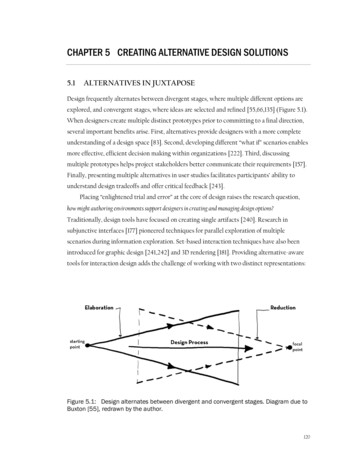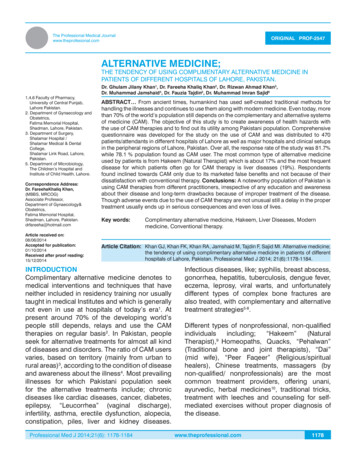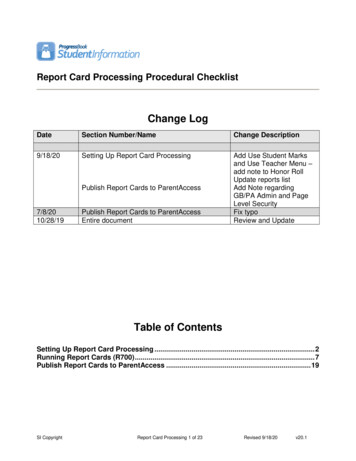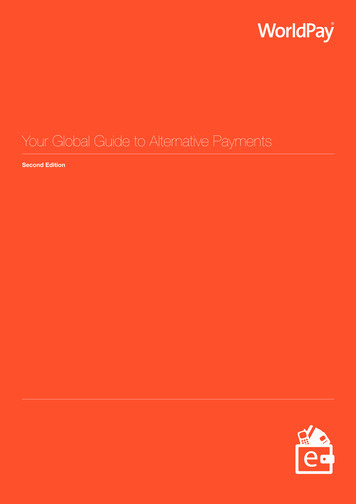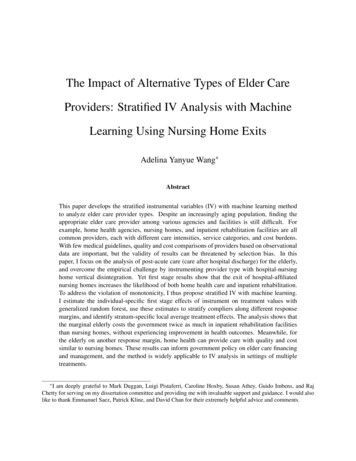
Transcription
The Impact of Alternative Types of Elder CareProviders: Stratified IV Analysis with MachineLearning Using Nursing Home ExitsAdelina Yanyue Wang AbstractThis paper develops the stratified instrumental variables (IV) with machine learning methodto analyze elder care provider types. Despite an increasingly aging population, finding theappropriate elder care provider among various agencies and facilities is still difficult. Forexample, home health agencies, nursing homes, and inpatient rehabilitation facilities are allcommon providers, each with different care intensities, service categories, and cost burdens.With few medical guidelines, quality and cost comparisons of providers based on observationaldata are important, but the validity of results can be threatened by selection bias. In thispaper, I focus on the analysis of post-acute care (care after hospital discharge) for the elderly,and overcome the empirical challenge by instrumenting provider type with hospital-nursinghome vertical disintegration. Yet first stage results show that the exit of hospital-affiliatednursing homes increases the likelihood of both home health care and inpatient rehabilitation.To address the violation of monotonicity, I thus propose stratified IV with machine learning.I estimate the individual-specific first stage effects of instrument on treatment values withgeneralized random forest, use these estimates to stratify compliers along different responsemargins, and identify stratum-specific local average treatment effects. The analysis shows thatthe marginal elderly costs the government twice as much in inpatient rehabilitation facilitiesthan nursing homes, without experiencing improvement in health outcomes. Meanwhile, forthe elderly on another response margin, home health can provide care with quality and costsimilar to nursing homes. These results can inform government policy on elder care financingand management, and the method is widely applicable to IV analysis in settings of multipletreatments. I am deeply grateful to Mark Duggan, Luigi Pistaferri, Caroline Hoxby, Susan Athey, Guido Imbens, and RajChetty for serving on my dissertation committee and providing me with invaluable support and guidance. I would alsolike to thank Emmanuel Saez, Patrick Kline, and David Chan for their extremely helpful advice and comments.
IIntroductionPopulation aging is an increasingly important global issue. In the U.S., the size of the pop-ulation aged 65 plus is projected to more than double by 2050, and that of those aged 85 plus isprojected to more than triple (Reaves and Musumeci, 2015). Meanwhile, the prevalence of chronicconditions is also on the rise especially among the elderly. For example, while 4.7 million peopleaged 65 plus lived with Alzheimer’s in 2010, the number is projected to rise to 13.8 million by2050 (The Alzheimer’s Association, 2018).Despite rapidly increasing demand for elder care driven by this demographic shift, findingthe appropriate type of provider among various agencies and facilities can be challenging. For instance, home health agencies (HHAs), nursing homes (SNFs), and inpatient rehabilitation facilities(IRFs) are all common elder care providers in the U.S., each with different care intensities, servicecategories, and cost burdens. Since there are relatively few medical guidelines on how to meet thespectrum of elder care needs, quality and cost comparison of provider types based on observationaldata plays an important role in guiding government policies and informing consumers.In this paper, I compare the quality and cost of elder care across different types of providers,focusing on post-acute care (PAC), defined as formal care that helps patients recover from an acutehealth shock. While post-acute and long-term care are the two main sources of revenue in mostelder care providers, post-acute care encompasses better-defined needs and services, and thus fitswell with the purpose of provider type comparison. It is a common form of care and importantcomponent of health care expenditure, as approximately 40% of Medicare-covered inpatient hospitalizations are followed with post-acute care, costing Medicare 58.9 billion (MedPAC, 2019a)in 2017. In general, patients with health conditions that require least intensive care tend to get PACthrough home health services, while patients who need more intensive care tend to get admittedto inpatient rehabilitation facilities, and the nursing homes largely provide services for those in1
the middle1 . Despite substantial overlap in patient characteristics, these providers are reimbursedat very different rates, making the utilization of PAC accountable for as much as over 70 percentof unexplained geographic variation in U.S. health care spending (Institute of Medicine, 2013).Meanwhile, rigorous comparison across different providers is limited by the concern of selectionbias. For example, patients more prone to medical complications may be more likely to get PACat inpatient rehab facilities than at nursing homes, confounding the estimated effects of IRFs incommon OLS analysis.Selection bias in multiple treatment settings as described above is a common issue in empirical analysis, and it can be challenging to address with econometric methods developed for binarytreatment cases. For example, when the treatments are binary, instrumental variables (IV) can ensure causal identification as long as the assumptions of monotonicity, independence, exclusion, andfirst-stage hold. However, when the number of possible treatments is greater than two, standardIV analysis may not produce valid and interpretable results since the monotonicity assumption isoften violated. Taking the elder care analysis as an example, I instrument a patient’s elder careprovider using vertical disintegration of hospitals and nursing homes to overcome selection bias2 .Event study shows that the exit of hospital-affiliated nursing homes lowers the propensity of postacute care at any nursing home and increases the likelihood of both home health care and inpatientrehab. Such heterogeneity in the first stage effect of instrument on possible treatments thus violatesthe monotonicity assumption, and deems standard IV unfit for causal identification in this setting.While such violation can arise in binary treatment settings as well, it is much more prevalent incases where there are multiple treatment options or policy responses, such as elder care, education(Kline and Walters, 2016; Mountjoy, 2019), housing (van Dijk, 2019; Bergman et al., 2019), social insurance designs (Low and Pistaferri, 2015), and tax approximation models (Rees-Jones and1 Otherless common post-acute care providers include long-term care hospitals and swing bed at rural and criticalaccess hospitals.2 In 2000-2016, the number of hospital-affiliated nursing homes dropped by over a half, while the number offree-standing ones has remained relatively stable.2
Taubinsky, 2019).In a world where economists observe exactly how an instrument affects treatment selectionfor each individual, one can allow for violations of monotonicity in aggregate and separately identify LATE for compliers on different response margins. However, common nonparametric analysisof heterogeneous first stage effects can be severely constrained by the curse of dimensionality(Wasserman, 2006). For example, whether the instrument induces a patient to substitute PAC atnursing home with home care or inpatient rehab may be influenced by a large number of covariatesand their interactions, such as the socio-economic status of the patient, diagnosis and severity ofthe health shock, vertical structure of hospitals and elder care providers, and availability of eldercare agencies and facilities in the local health care market. Conventional heterogeneity analysismethods such as interacting instrument with these characteristic variables can quickly become intractable and prone to overfitting, and common nonparametric methods such as local maximumlikelihood estimators can be infeasible as data points become increasingly sparse in higher dimensional covariate spaces. Meanwhile, parametric modeling of treatment selection usually relies onstrong assumptions and may not adequately capture the complexity of underlying decision-makingprocess. Existing methods often also require special properties of the instrument, which may notbe readily applicable in empirical settings (Lee and Salanié, 2018).Hence in this paper, I propose an advanced applied econometrics method named stratifiedIV with machine learning, harnessing machine learning’s power in nonparametric estimation ofheterogeneous treatment effects with high dimensional data. I apply recent developments in machine learning to estimate the individual-specific first stage effects, use these estimates to stratifycompliers along different response margins, and identify stratum-specific local average treatmenteffects (LATEs). Specifically, I recast the treatment selection problem with potential outcomesframework, and estimate individual-specific conditional first stage effects of instrument on treatment values through generalized random forest. Adapting from classification and regression tree3
(Breiman et al., 1984) and random forest (Breiman, 2001), generalized random forest (Athey et al.,2019) allows for accurate and flexible estimation of heterogeneous treatment effects by recursivelypartitioning the sample into leaves within which individuals experience similar treatment effectsand across which the effects are as heterogeneous as possible. The partitioning (aka "tree growing")is repeated on different random subsamples and with random subsets of covariates, and the aggregation of trees forms a random forest. The treatment effects conditional on all observed covariatesare then estimated through a local maximum likelihood estimator, where kernel weights are basedon the frequency when each individual ends up in the same leaf as those with the covariates ofinterest. These individual-specific first stage effects thus allow for complier group stratificationand stratum-specific LATE estimation, relaxing the monotonicity assumption in aggregate as longas it holds within a complier bucket. Therefore the proposed method – stratified IV with machinelearning – effectively overcomes the curse of dimensionality and extends the application of IVwithout imposing strong functional form or behavioral assumptions.I thus apply the stratified IV with machine learning method and use generalized random forest to estimate conditional first stage effects of the termination of hospital-affiliated nursing homeson the choice of PAC provider types, based on a wide range of observables such as patients’ sociodemographic information, baseline health conditions, principal diagnosis codes, absolute and relative distance to nearest home health agency (HHA), inpatient rehabilitation facility (includinghospital with IRF units), and long-term care hospital, and state-year average share of patients getting different types of PAC in a held-out sample 3 . To address concerns of potential overfitting, Irandomly split the sample into two halves, one to build the random forest, and the other to predictthe individual-specific first stage effects based on the random forest partitioning. Patients in thesecond subsample are then stratified into groups of nursing home to home care compliers and nursing home to inpatient rehab compliers according to the relative first stage estimates on home care3 Heldout sample consists of inpatient hospitalizations at hospitals that do not have any affiliated SNF throughout2001 - 2015, while satisfying all sample restrictions for the treatment and control samples.4
and inpatient rehab propensities. Within each stratum, all standard IV assumptions (independence,exclusion, first stage, and monotonicity) should thus hold, and the stratum-specific local averagetreatment effects can be identified through two stage least squares.The results show that patients who shift to inpatient rehab care after hospital-affiliated nursinghome exits do not experience significant changes in mortality or inpatient readmission rates, butcost Medicare twice as much for the hospitalization and institutional post-acute care. Similarly, onecannot reject the null that the compliers shifting from nursing home to home care experience littlechange in health outcomes and utilizations. The results suggest that while inpatient rehab facilitiescould provide similar quality PAC when nursing homes become less available, the difference incare quality may not fully justify the higher cost. Meanwhile home health services could indeedprove to be a viable alternative to nursing home care with similar quality at no higher cost.Empirically, this paper adds to the growing literature analyzing the impacts of elder careprovider types on PAC quality and cost (Rahman et al., 2017; Werner et al., 2019; Rahman et al.,2013, 2016; Konetzka et al., 2018). The paper extends empirical strategy beyond common distancebased instruments in the literature to account for the concern that distance to PAC facilities may beconfounded by other factors of the local health care market. More broadly, the paper contributesto the literature on vertical integration in the health care sector and the impact of institution ownership on health cost and outcomes (Gaynor et al., 2017; Brot-Goldberg and de Vaan, 2019; Duggan,2000).Methodologically, this paper contributes to the recent and growing literature on generalizingIV from binary to multiple treatment settings. Most of the literature still assumes monotonicityand develops methods to separately identify counterfactual-specific subLATEs (Kline and Walters, 2016; Feller et al., 2016; Kirkeboen et al., 2016; Hull, 2018; Mountjoy, 2019; Mogstad et al.,2019). Moving away from strict or ordered monotonicity assumption, Heckman and Pinto (2018)show conditions under which choice behaviors ensure unordered monotonicity, and characterize5
IV estimators as weighted average of the margin-specific LATEs. Lee and Salanié (2018) fully relax the monotonicity assumption by modeling treatment selection as a vector of threshold-crossingrules, while highly model-specific and requiring enough continuous instruments. This paper relaxes the monotonicity constraint from aggregate to group-specific by applying machine learningto estimate individual-specific first stage effects, thereby allowing for identification of complierspecific LATEs in multiple treatment settings without strong model assumptions or special instrument properties. It is at the forefront of using machine learning to overcome bottleneck appliedeconometric challenges, and illustrates the applicability of the method to empirical analysis withhigh dimensional data in a natural experiment setting.The rest of the paper proceeds as follows. Section 2 discusses the institutional backgroundof post-acute care. Section 3 describes the data, summary statistics, and findings from averageeffect analysis. Section 4 develops the stratified IV with machine learning method, and Section 5applies it to analyze the quality and cost of post-acute health care across different types of eldercare providers. Section 6 concludes.IIBackground of Post-Acute Care and ProvidersII.1Types of PAC Providers and Medicare Reimbursement PoliciesPost-acute care (PAC), defined as formal care that helps patients recover from an acute healthshock, is a common form of health care and one of the two main sources of revenue (the otherbeing long-term care) for most elder care providers. The most important payer of PAC in the U.S.is Medicare4 , which is the largest payer of health care for the elderly. The total annual expenditure4 Notethat all the policies discussed in this section and all analysis in this paper only pertain to original (fee-forservice) Medicare, as Medicare Advantage enrollees may face drastically different rules and may not have high qualitydata in the Medicare datasets used in this paper.6
on all original Medicare (fee-for-service) PAC services is around 59 billion, following over 1million inpatient hospitalizations (MedPAC, 2019a). From 2001 to 2013, Medicare payment toPAC providers more than doubled (MedPAC, 2015), as Chandra et al. (2013) identified PAC as thefastest growing major health care spending category in 1994 - 2009.Importantly, the choice of PAC provider type and corresponding cost varies dramatically inthe U.S. The most common elder care providers that offer PAC for Medicare beneficiaries arehome health agencies (HHAs), nursing homes (skilled nursing facilities, aka SNFs), and inpatientrehabilitation facilities (IRFs). Among these, nursing homes have the largest share of PAC spending ( 28.7 billion in 2017), followed by home health agencies ( 18.0 billion), and inpatient rehabfacilities ( 7.9 billion) (MedPAC, 2019a). As shown in Table 1 and Figure 1, the share of patientsgetting PAC at each type of providers after an inpatient hospitalization also roughly follows thisorder. Partly due to a lack in definitive medical guidelines on optimal form of PAC, the choice ofPAC provider type can be heavily influenced by non-clinical factors such as local practice patterns,availability in local health care market, patient preferences, financial incentives of providers, andvertical relations between hospital and elder care providers (MedPAC, 2015; Buntin et al., 2005).With such large differences in payment rates and utilization across PAC provider types, Institute ofMedicine (2013) estimates that PAC alone could account for 73 percent of unexplained geographicvariation in health care cost across the U.S. in 2013.While Medicare pays for eligible PAC services at all certified providers, the reimbursementpolicies are different across provider types. Beneficiaries are eligible to get PAC at nursing homesif the stay follows an inpatient hospitalization of more than 3 days5 . The reimbursement of nursing home care is on a per-diem basis. Medicare covers the full cost in the first 20 days of SNFstay, requires daily beneficiary coinsurance in the 21st - 100th day of the stay6 , and stops payingaltogether after the first 100 days. The rates of reimbursement for the SNFs are determined by5 Except6 Forif readmitted to SNF within a Medicare benefit perioddual-eligibles, the copayment is usually paid for by Medicaid.7
the resource utilization groups (RUGs) of the patients, which is based on the intensity of care andseverity of health conditions (CMS, 2015, 2018). Home health agencies tend to provide post-acutecare for patients with less intensive needs, and are reimbursed for each 60-day episode, regardlessof the number of home health services provided during the episode7 . Inpatient rehab facilitiesmainly target patients who need intensive rehabilitation therapy and careful coordination with amedical team. The IRFs receive higher reimbursement rates than SNFs and are thereby required todemonstrate that they are indeed providing services to patients who are in need of such intensivecare. One important regulation is the "60 percent rule", which mandates that at least 60 percentof the total inpatient population at the IRF must need treatment for at least one of the 13 medicalconditions such as stroke, spinal cord injury, amputation, hip fracture, brain injury, and neurological disorders8 . The reimbursement is fixed for each IRF stay, adjusted for patient’s clinicalcharacteristics and expected resource uses, as well as other facility-level factors (CMS, 2019).Besides the types discussed above, there are other providers of inpatient and outpatient PAC.For example, long-term care hospitals (LTCHs) began as a carve-out of hospital prospective payment system to provide care for patients whose average length of stay is 25 days or more. Gradually, LTCHs start providing PAC services that are arguably similar to those at SNFs (but get reimbursed at higher rates) (Einav et al., 2019). Conditions for patients receiving care at LTCHs arehighly concentrated, with the top 25 MS-LTC-DRGs accounting for almost 70 percent of LTCHdischarges and respiratory conditions alone accounting for over 35 percent of all LTCH cases(MedPAC, 2019a). Since LTCH is a relatively small share of total PAC observations in the Medicare data and is relatively less affected by the termination of hospital-affiliated nursing homes, Ido not discuss it extensively in this paper. PAC can also be provided at swing beds in rural andcritical access hospitals, which are designated hospital beds that can be used for either inpatientcare or post-acute care. Swing bed PAC tends to be similar to those at SNFs, but accounts for a7 The8 Theepisodes can be re-certified indefinitely as long as beneficiary could demonstrate medical need.full list of the 13 conditions can be found in the appendix.8
much smaller share of Medicare patients. To minimize confounds, I exclude all hospitals that haveswing beds from the main analysis in this paper.Despite the large variation in costs, evidence on care quality and health outcomes across different types of PAC providers has been scarce, largely focusing on a limited set of conditions (suchas hip fracture and stroke) and often leading to contradicting conclusions. The lack of consistentquality measures and selection bias are the most important challenges for empirical analysis. Forexample, patients admitted to IRFs are expected to tolerate and benefit from intensive therapies9 ,and thus may be healthier than those getting PAC at SNFs. On the other hand, patients more proneto medical complications may also be more likely to get PAC at inpatient rehab facilities than atnursing homes. Estimates of PAC provider effects in common OLS analysis are thus likely confounded by the patient and case mix. When comparing patient outcomes and Medicare spendingbetween home health agencies and nursing homes, Werner et al. (2019) uses their relative distanceas instruments to address selection bias, and finds that home health service saves significant costbut is associated with higher readmission rates. But the distance based IV can be hard to generalizeto comparison between SNFs and IRFs. There are almost ten times as many SNFs than IRFs inthe U.S., and thus patients living closer to an IRF may have access to a very different health caremarket than those living farther away.Therefore, even though the Medicare payment advisory committee (MedPAC) has for yearsrecommended Congress to unify PAC reimbursement, such attempts remain challenging withoutstrong evidences on care quality across PAC provider types, potentially costing Medicare billionsof dollars each year (MedPAC, 2019b; Einav et al., 2019). Meanwhile, with the rise of new payment systems such as bundled payment and accountable care organizations (ACOs), reducing PACat institutional settings has become an increasingly common cost-saving measure (McWilliamset al., 2017; Werner et al., 2019). Although the literature does not find strong average effects of the9 Thepatients typically receive therapy for at least 3 hours per day, at least 5 days a week. (MedPAC, 2019a).9
reduction of institutional PAC, average treatment effect may mask large heterogeneity in treatmenteffects and may ignore groups of individuals who are particularly vulnerable to the policy.II.2Trend of Vertical IntegrationThere has been a steady decline in the degree of vertical integration between hospitals andvarious types of elder care providers. The most stark trend is the massive terminations of hospitalaffiliated nursing homes in the last two decades. As shown in Table 2 and Figure 2, the number ofhospital-affiliated SNFs in 2016 is less than half of the level in year 2000, while the number of freestanding SNFs has remained relatively stable. Prior literature and the industry has attributed thedecline to the introduction of Medicare prospective payment system (PPS) for SNFs in 1998 whichreimbursed hospital-owned SNFs at the same rate as free-standing ones, making them much lessprofitable than when paid at cost. However, Figure 2 and Figure 3 show that although the termination of hospital-affiliated SNFs started and peaked around the time of SNF PPS introduction, thetrend has been steady and lasted for almost two decades. The trend of vertical disintegration is thusarguably unlikely to be a sharp response to a large policy change, but rather a gradual evolutionthat shapes current landscape of vertical relations between hospital and elder care providers.The vertical disintegration is also happening for hospital IRF units. While the majority ofinpatient rehabilitation facilities are still distinct units within a short-term hospital, the IRFs areslowly shifting towards more free-standing IRFs in the recent years (MedPAC, 2019a). As shownin Figure 3, there has been a wave of hospital IRF unit terminations since 2006, albeit smaller inmagnitude compared to that of hospital-affiliated SNFs.In this paper I focus on the termination of hospital-affiliated SNFs and exclude hospitals thatexperience concurrent changes in IRF unit status from the main analysis, since among hospitalsthat experienced termination of affiliated SNFs, there does not seem to be a stark pattern in IRF10
establishment or termination immediately preceding or following the SNF exit. Indeed, there are250 terminations of hospital-affiliated SNFs in 2008 - 2014, among which only 22 had IRF unitestablishment or closure up to 5 years prior to SNF termination10 and 24 had IRF unit establishmentor closure up to 5 years afterwards11 .IIIData and Summary StatisticsIII.1DataThe main source of data is the universe of fee-for-service Medicare claims for all inpatienthospitalizations and institutional post-acute care (aka MedPAR) in 2006-2015. MedPAR containsdetailed medical information on each patient’s health condition (admission and discharge dates,diagnoses, types of admission, etc.), institutional information on the name and type of health carefacility, and financial information on Medicare reimbursement and patient coinsurance and deductible. Each year, there are around 3.3 million observations in the MedPAR data, of whicharound 2.5 million are for short-term inpatient hospital stays.The MedPAR data is then complemented by the Medicare beneficiary summary files (MBSF)with demographic and socio-economic information (age, gender, race, dual-eligible status, PartD low-income subsidy status, original type of eligibility), and baseline chronic health conditionindicators.Furthermore, I use CMS Provider of Service (POS) files in 2006 - 2015 for more detailedinformation on each health care facility (initial certification and termination dates, type, size, address) and the vertical relations among the providers. To illustrate the number of hospital-affiliated10 911 9are IRF unit establishments and 13 are terminationsare IRF unit establishments and 15 are terminations11
vs. free-standing SNFs, I also use LTCFocus data compiled at Brown University School of PublicHealth from multiple sources (such as OSCAR/CASPER and MDS).III.2Sample ConstructionThe treatment group includes inpatient hospitalizations in 2007 - 2015 at short-term hospitals(excluding critical access hospitals and hospitals with swing beds) that experience terminationof affiliated SNFs in 2008 - 2014 and do not have any change in IRF unit affiliation status orany other change in affiliated SNFs in 2001 - 2015. (The vertical structure of hospitals and PACfacilities are determined through the POS records.) The selection criteria makes sure that there areminimal confounds from changes in other types of medical-PAC integration during the analysisperiod. Moreover, patients who died during inpatient hospitalization are also excluded since theymay confound the analysis of PAC’s impact on mortality. Additionally, all samples are restricted toMedicare beneficiaries who are aged 67 and above and have enrolled in fee-for-service Medicarefor at least 12 months prior to the inpatient hospitalization. The restriction allows constructing andcontrolling for baseline health condition for the analysis. Also note that in all samples, none of theinpatient hospitalizations include inpatient rehabilitations at short-term hospitals’ IRF units. Theanalysis sample keeps observations from 3 years before the SNF termination to 3 years afterwards,and has 128 hospitals and 257,526 total observations in the treatment group.The criteria for selecting control group is similar to that of the treatment group, except that thehospitals included in the control group have affiliated SNFs throughout 2001 - 2015. The analysissample includes 285 hospitals and 632,985 observations for the control group.To validate the accuracy of PAC type following each inpatient hospitalization and the affiliation status of SNF and IRF units with hospitals, I do two additional steps of data cleaning.First, I check whether each inpatient hospitalization indeed has a corresponding PAC record12
according to the discharge destination field in the hospital MedPAR data. The hospital and PACrecords are matched by the date of hospital discharge and institutional PAC facility admission.To ensure there is no systematic mis-coding around the termination of hospital-affiliated SNFs,I drop all individuals who’ve ever had discharge destination coded as institutional PAC but nocorresponding MedPAR record, or who’ve had discharge destination coded as home/home care butmatched with institutional PAC in MedPAR. Additionally, if the MedPAR record type or institutiontype does not agree with the discharge destination in the inpatient hospitalization record, I correcttheir destination code according to actual PAC type observed in the matched institutional PACrecord.Second, I check the validity of SNF and IRF unit affiliations in the POS files by merging themwith the medical-PAC paired MedPAR sample. For the treatment
I am deeply grateful to Mark Duggan, Luigi Pistaferri, Caroline Hoxby, Susan Athey, Guido Imbens, and Raj Chetty for serving on my dissertation committee and providing me with invaluable support and guidance. I would also . IV with machine learning, harnessing machine learning's power in nonparametric estimation of






